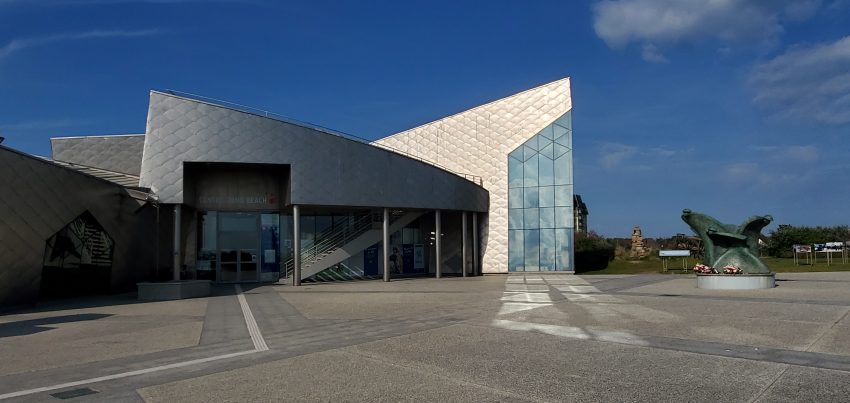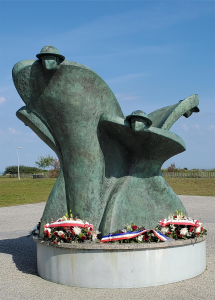 Today many people will celebrate the 80th anniversary of the landings in Normandy. Few of the men and women who participated in the strike that brought about the end of the Second World War are still alive, so it falls to us to remember that it was their valour and bravery that allow us to travel freely throughout Europe. Our visit to the Normandy region of France last month was our opportunity, along with a small group of fellow Canadians, to tour the Juno Beach Centre and the surrounding area. To say that we did so with a tremendous amount of national pride would be an understatement.
Today many people will celebrate the 80th anniversary of the landings in Normandy. Few of the men and women who participated in the strike that brought about the end of the Second World War are still alive, so it falls to us to remember that it was their valour and bravery that allow us to travel freely throughout Europe. Our visit to the Normandy region of France last month was our opportunity, along with a small group of fellow Canadians, to tour the Juno Beach Centre and the surrounding area. To say that we did so with a tremendous amount of national pride would be an understatement.
The Juno Beach Centre opened it’s doors in 2003 as a place for veterans and families to go to remember and learn. The museum offers an excellent display of memorabilia and stories about Canadian efforts during the Second World War. Along with the static displays and moving videos you can tour two underground German bunkers, which we did with our guide Emma, an intern from Vancouver. All guides at the Centre must be Canadian and between the ages of 18 and 24, the age at which most young men and women fought. Afterwards you can walk along Juno Beach itself. The day of our visit was peaceful and sunny yet after our tour of the Centre we were able to envision what it may have been like on that fateful day.
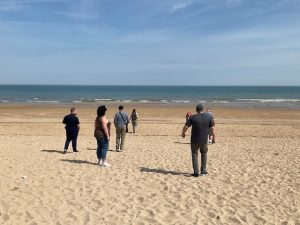
From there our driver took us to Canada House, the first home liberated by the The Queen’s Own Rifles of Canada army regiment that day. It is a large home facing Juno Beach, and still occupied privately so you cannot enter. It has become a place of pilgrimage for many Canadians to pay their respect. There is a large monument located next to it honouring all the countries that participated in the Second World War.
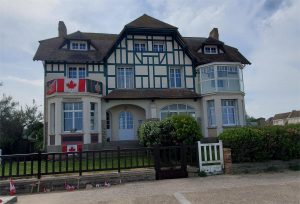
We then stopped at the Canadian Cemetery of Beny-sur-Mer to waonder among the rows of well tended crosses. The cemetery is fronted by three large shady maple trees with a monument centre to it all festooned with wreathes of poppies. We found a small container of notes presumably written by Canadian high school students on a class trip. Reading through them was a moving tribute to the youth of today as they honoured the youth of the past.
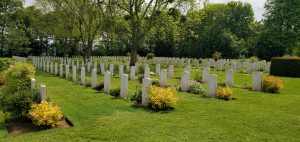
We ended our drive at the Ardenne Abbey where 20 Canadians were murdered by German troops after being taken as prisoners of war. I was especially moved when I discovered that one of the fallen was a young man from my own home town of St. Thomas, Private James Elgin Bolt.
Our tour involved a driver only as we were unable to get a guide on that day. The locations we visited and their importance was easy to research online beforehand. Most of our time was spent at the Centre and it provided the basis for everything we needed to know to appreciate the region.
It was an emotional, moving day; at times sad and other times filling us with intense pride. Best of all we shared it with a like minded group of new friends from across Canada. We will be forever bonded by our experience.
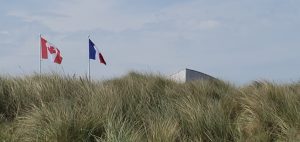
Some fourteen thousand Canadians stormed Juno Beach that day, and launched a campaign that helped turn the tide of the Second World War. D-Day and the Battle of Normandy was one of the most significant chapters in Canada’s military history. On 6 June 1944, some 14,000 Canadian troops from the 3rd Canadian Infantry Division and the 2nd Canadian Armoured Brigade stormed the beaches of Normandy. More than 450 members of the 1st Canadian Parachute Battalion jumped inland before dawn on 6 June 1944. They were the first Canadians to engage the enemy on D-Day.
On 25 August 1944, the Allies liberated Paris, officially ending the Battle of Normandy. More than 5,000 brave Canadians died—and over 13,000 were wounded—during this campaign. They helped to end the Second World War. More than one million Canadians and Newfoundlanders served on land, in the air and at sea during the Second World War. It is our duty to keep their stories alive, recognize their courageous efforts and honour their sacrifices. (From Veterans Affairs Canada).
Additional photo credit to Jude Gatt with our thanks.
